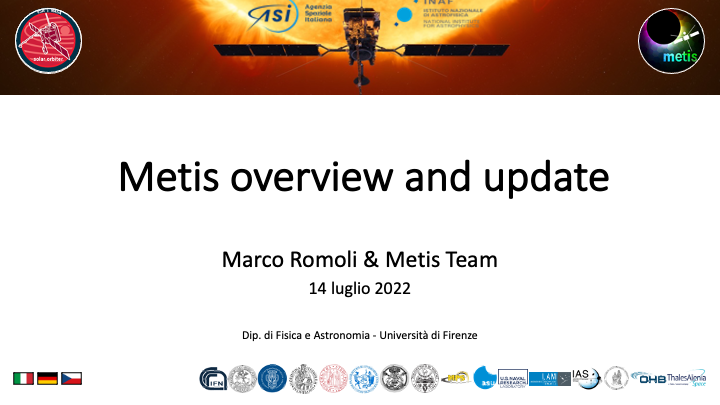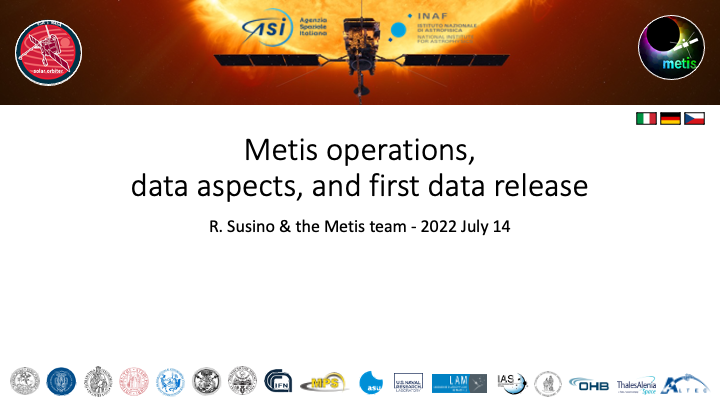News
News
2021 2020 2019 Earlier
2022
The first Metis Data Release is now available
July 14, 2022
On July 14th, the first public release of Metis data has been presented to the Metis community in a dedicated online meeting.
After an update given by Metis PI, Marco Romoli, on Metis status, on the instrument functionality after the stop occurred at the beginning of 2022, due to an anomaly of the UV detector, and on the science that has been done and that will be done in the future, Metis Level-2 data have been presented and described in detail.
The two presentations can be downloaded here.
The first Metis data release, covering the first part of the Solar Orbiter Nominal Mission Phase, will be available soon on the Solar Orbiter Archive; in the meantime it can be downloaded from the cloud as described in the Data Access section of this webpage.
Solar Orbiter closer than ever to the Sun
May 18, 2022
On March 26th, the ESA/NASA Solar Orbiter mission was at only ~ 40 million km from the Sun, acquiring stunning images of the solar atmosphere. This event was the first close perihelion of the satellite that will make in its orbits around the Sun, from now on, two close passages per year.
Among the instruments on board Solar Orbiter, also the Metis coronagraph realized spectacular observations of the Sun with an extraordinary level of detail, at only one third of the distance between the Earth and the Sun.
The Metis images of the solar corona show the very high dynamism of the solar magnetic field during explosive events, i.e. CMEs (Coronal Mass Ejections), that shake the Sun’s atmosphere. Metis took pictures of the fainter corona from 1.7 to 3 solar radii, by blotting out the Sun’s bright disc and revealed the same details as ground based total eclipse observations, but observing continuously instead of a few minutes.
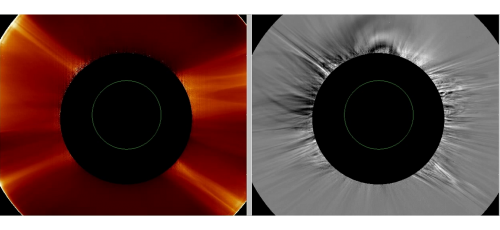
Solar corona polarized image acquired with Metis
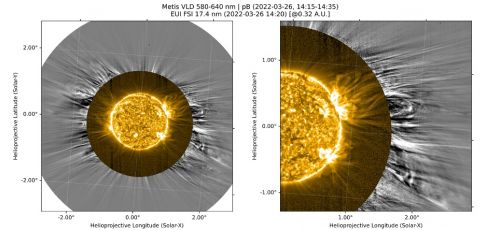
Composite image. In yellow the Sun image acquired by EUI/FSI and in grey the solar corona image acquired by Metis (Credits: ESA&NASA Solar Orbiter/EUI Team/Metis Team)
The next close perihelion passage for Solar Orbiter, and Metis, is foreseen for October 2022. In the meantime, the Metis scientific team will have to analyze the images already taken and will plan for the next in-flight calibration and scientific sequences to be acquired.
Metis UV detector recovery
April 12, 2022
Due to an unexpected overcurrent in the HV circuit of the delicate UV detector intensifier, Metis observations came to a stop on January 4, 2022.
An investigation was carried on to understand the cause of the overcurrent and to assess that a possible detector failure could not propagate to the rest of the instrument.
The visible channel observations were resumend on February 22 and a careful recommissioning of the UV detector was scheduled after the first perihelion transit of Solar Orbiter.
On April 12, the UVD was successfully powered on with a flawless procedure and a nominal telemetry. The UVD will be switched on again for science acquisitions during the Parker Solar Probe - Solar Orbiter quadrature on June 1-2, 2022, and across the October 12, 2022 perihelion.
Radiometric calibration will also take place using stars crossing Metis field-of-view in order to assess the new gain of the detector.
2021
The first scientific results of the Metis coronograph
August 1, 2021
The first two scientific papers obtained with data from the Metis coronograph aboard the Solar Orbiter spacecraft are going to be published in Astronomy & Astrophysics: “First light observations of the solar wind in the outer corona with the Metis coronagraph” and “Cosmic-ray flux predictions and observations for and with Metis on board Solar Orbiter”.
The first article analyzes the images of the extended solar corona obtained for the first time simultaneously in polarized visible light (580-640 nm) and in the ultraviolet (Lyman-α line of neutral hydrogen at 121.6 nm) by Metis on 15 May 2020.
The analysis exploits the Doppler-dimming technique, which allows the measurement of the solar wind speed on the plane of the sky based on the attenuation of the intensity of the Lyman-α line with respect to the intensity expected for a static corona (without wind), starting from the physical parameters of the solar corona including the electron density of the plasma derived from the polarized-brightness images.
In this way, the first ‘instantaneous shot’ of the speed of the wind that is accelerated in the solar corona was obtained. Thanks to these observations it was possible to identify the regions of the solar corona where the so-called ‘slow’ solar wind (i.e. with speeds measured near the Earth between about 300-400 km/s) originates.
The high resolution global maps of the solar wind velocity in the corona show a denser layer about 20° wide, centered on a quiet equatorial streamer, a structure extending in corona above the eastern limb of the solar disk, where the wind speed is about 160 km/s at a distance from the center of the Sun ranging from 4 to 6 solar radii. In the regions adjacent to the higher density layer, the wind speed increases rapidly, marking the transition between slow and fast wind in the corona.

Visible-light polarized brightness (580-640 nm; left panel) and ultraviolet H I Lyman-α emission (at 121.6 nm; right panel) of the solar corona observed by Metis from 0.64 AU (Astronomical Units) from the Sun, on May 15, 2020.
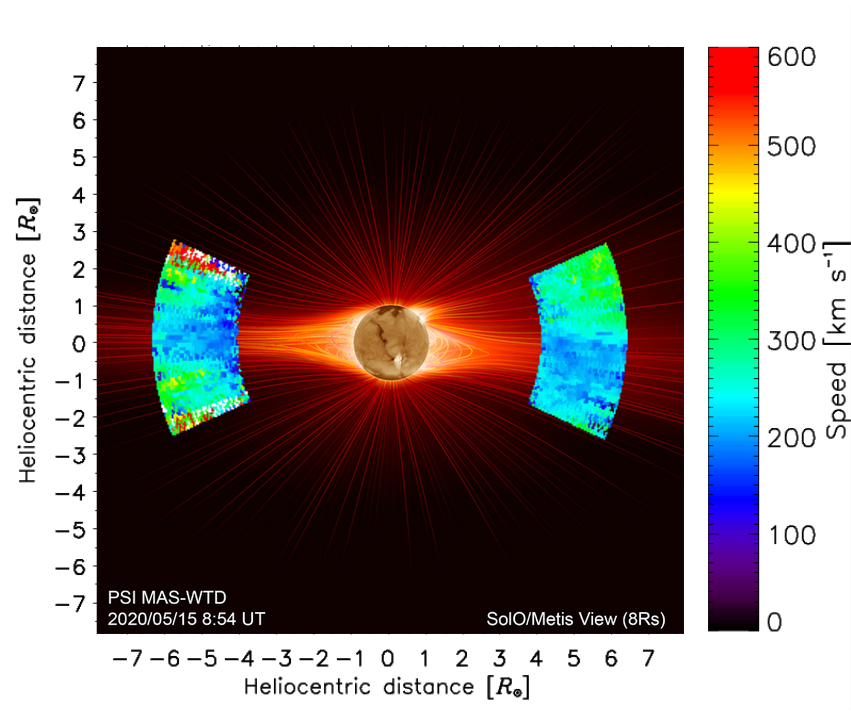
Neutral hydrogen outflow velocity map, in the case of isotropy of the neutral hydrogen kinetic temperature along the radial direction.
The second article presents a study of the traces of cosmic rays of galactic origin revealed in the first visible-light images obtained by Metis during the commissioning phase of Solar Orbiter this spring. The comparison of the traces observed in the visible-light images of Metis with the results of Monte-Carlo simulations of the interaction of cosmic rays with the visible-light detector allowed us to establish that cosmic rays affect only a small fraction (1 in 10,000) of the detector pixels. A similar study will be conducted during the mission to carry out instrumental diagnostics and verify whether the Metis data, together with the Monte-Carlo simulations, allow long-term monitoring of the proton flux of galactic origin.
Solar Orbiter’s multi-instrument view of a coronal mass ejection
May 17, 2021
Combining imagery from three of Solar Orbiter’s remote sensing instruments – the Extreme Ultraviolet Imager (EUI), the Metis coronagraph, and Solar Orbiter’s Heliospheric Imager (SoloHI) – provides both close-up and wide views of the evolution of a coronal mass ejection (CME) on 12-13 February 2021. CMEs are eruptions of particles from the solar atmosphere that blast out into the Solar System.
This compilation, presented by ESA in the movie below, starts with a view of the full Sun from EUI, with the CME circled at lower left. These images (yellow) show the lower part of the Sun’s corona (atmosphere) as the CME first leaps out into space.
Metis, the Solar Orbiter’s coronagraph, blocks the light from the solar surface (represented as the black region with no data), allowing the Sun’s fainter, outer corona to be seen. The Metis field of view (red/orange) captures the CME as it extends from about 2.9-5.6 solar radii, followed by a smaller scale eruption possibly related with the post-CME reconfiguration of the solar corona.
Finally, the movie zooms out to show SoloHI’s observations (gray) of the CME, which span from 8.5 solar radii to 45 solar radii, or 0.2 AU (where 1 AU, or astronomical unit, is the Earth–Sun distance). SoloHI images the solar wind – the stream of charged particles constantly released by the Sun into outer space – by capturing the light scattered by electrons in the wind.
Happy 1st Solar Orbiter launch anniversary!
February 10, 2021
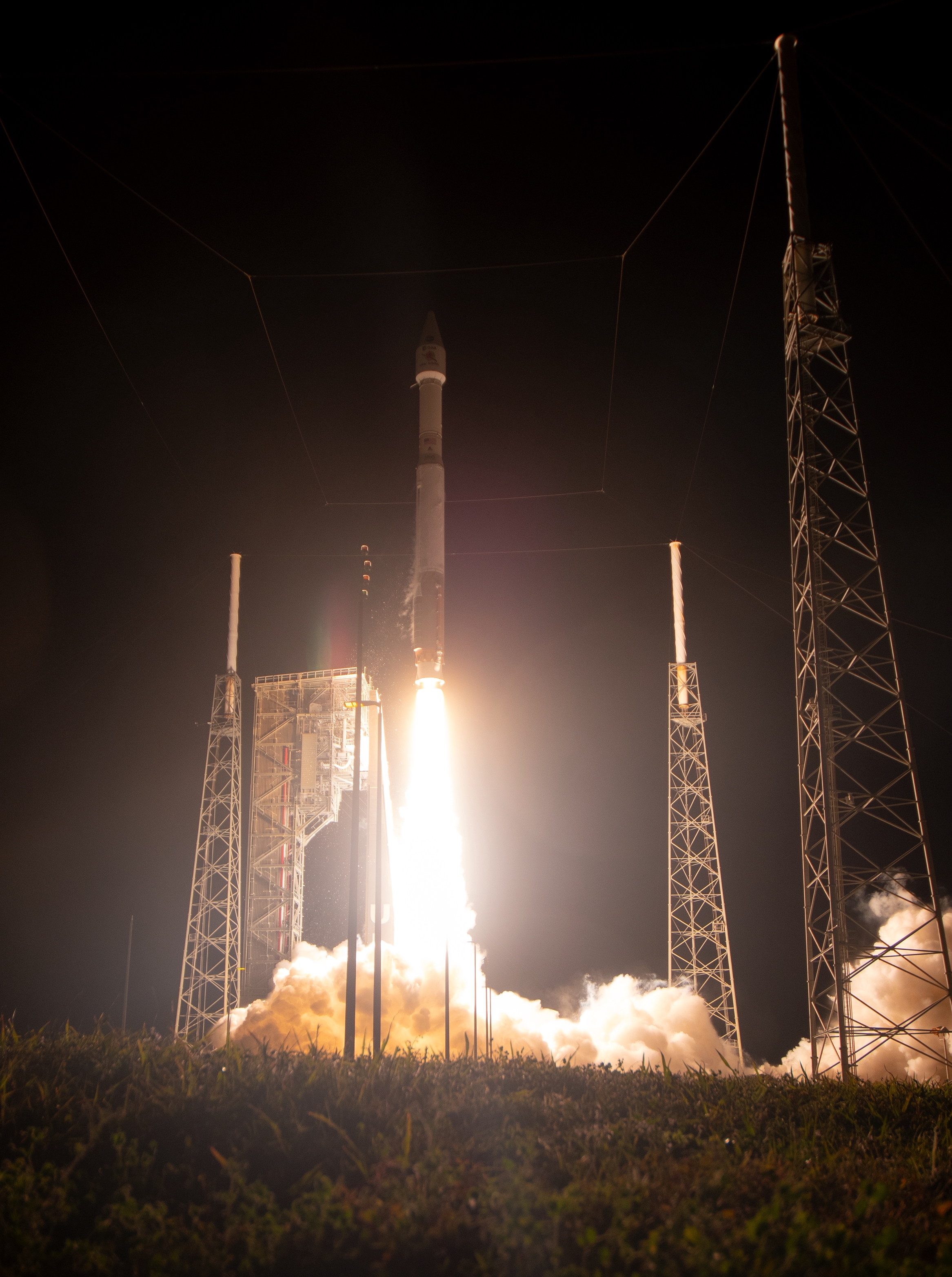
ESA’s new Sun exploring spacecraft Solar Orbiter launched atop the US Atlas V 411 rocket from NASA’s Kennedy Space Center in Cape Canaveral, Florida, at 04:03 GMT (05:03 CET) on 10 February 2020 (credits: ESA - S. Corvaja).
Parker Solar Probe and Metis/Solar Orbiter first quadrature
January 20, 2021
On January 18, 2021, Solar Orbiter and Parker Solar Probe (PSP) were for the first time in a special orbital configuration, that is, in quadrature. At this time when travelling along its orbit very close to the Sun, PSP has been crossing the atmosphere of the Sun at a distance just above 20 solar radii.
Because of the continuous expansion of the solar corona, the plasma crossed by PSP, which is moving outward at a speed above 100 km/s on the solar equatorial plane, is the same plasma observed with the Metis coronagraph just a few hours earlier at a distance of 3-7 solar radii from the solar limb. It is, thus, the first time that the expanding coronal plasma – that is, the solar wind – fully characterized by observations remotely performed with Metis, encounters almost immediately in its way outward a suite of in-situ instruments that can directly measure its physical properties. Data analysis is on-going.
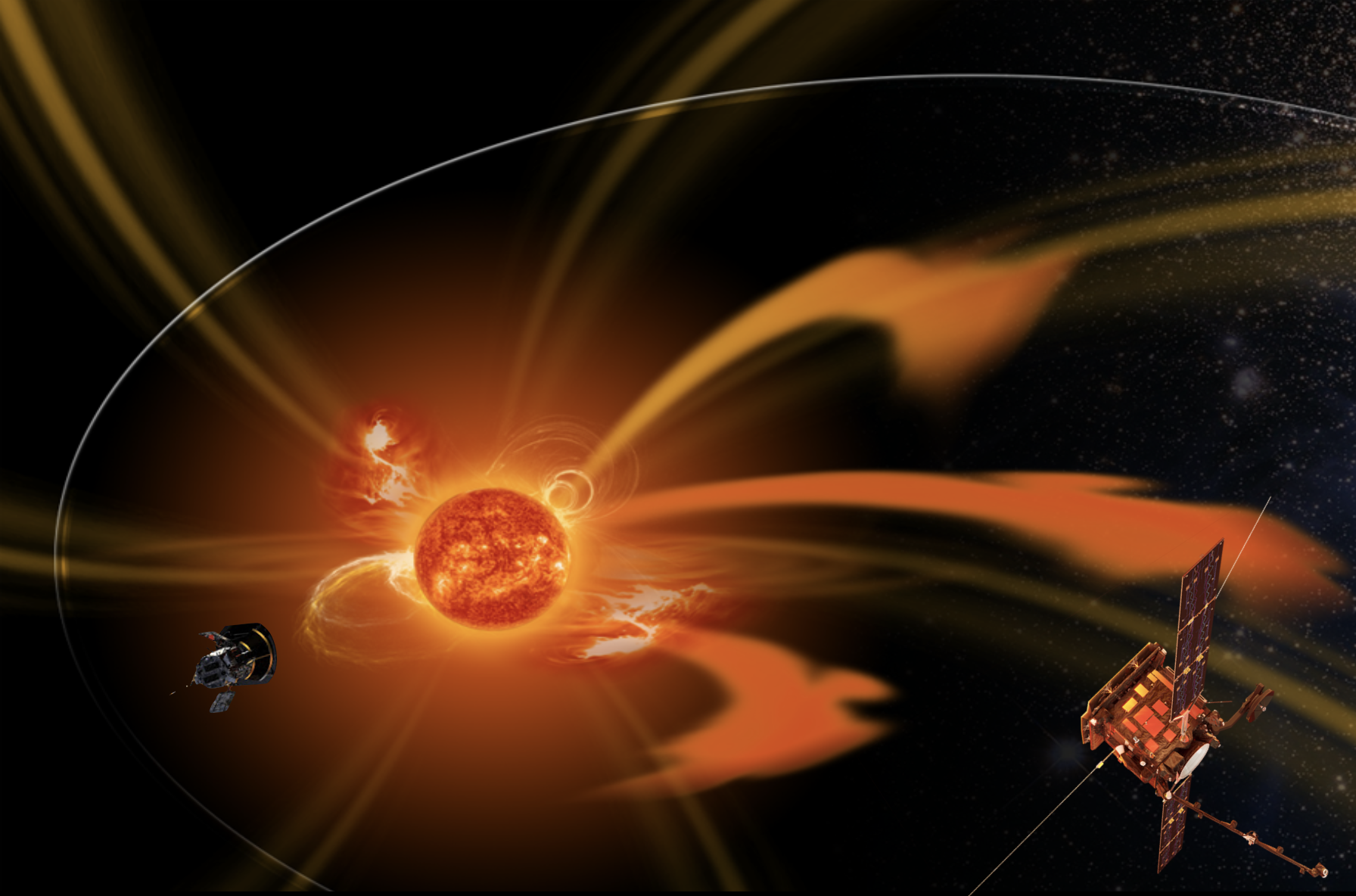
Artist's representation of the PSP and Solar Orpiter quadrature.
2020
Solar Orbiter first-light press release
July 16, 2020
The Metis coronagraph on ESA’s Solar Orbiter scored a couple of ‘world firsts’ with its first light image. Metis’ first light images, taken on 15 May 2020, and displayed below in the left hand column, are the first simultaneous images of the corona taken in both visible light (580-640 nm) and ultraviolet light (UV, 121.6 nm).

The visible light image (shown in green) clearly shows the two bright equatorial streamers and fainter polar regions, which are characteristic of the solar corona during times of minimal magnetic activity. The ultraviolet image (shown in purple) records emission from neutral hydrogen atoms in the corona. This is the first UV image of the extended solar corona ever obtained. When Metis took these images, Solar Orbiter was at a distance of 0.6 Astronomical Units (AU; one AU is equivalent to the average distance from Earth to the Sun, about 150 million kilometres) from the Sun and the instrument field of view covered heights from 3.8 to 7.0 times the solar radius from the Sun’s centre.
Metis also captured simultaneously visible and UV images on 21 June 2020, soon after Solar Orbiter’s first perihelion (approaching the Sun from 0.52 AU on 15 June). These are shown in the right hand column. The instrument field-of-view covers heights from 3.2 to 5.8 times the solar radius from the Sun’s centre. Already at this distance, the spatial resolution of these images is comparable or better than any coronagraph on ground or in space. Better resolution in visible light can only be achieved during the few minutes of the natural total eclipse of the Sun, while the UV images have no match. During its nominal mission, Solar Orbiter will venture much closer to the Sun (up to 0.28 AU), providing even more detailed images.
Metis Internal Occulter repointing
May 15, 2020
The internal occulter has been repositioned, by means of a ticklish step-by-step procedure when for each position of the internal occulter mechanism, a visible light image was sent to ground and inspected.
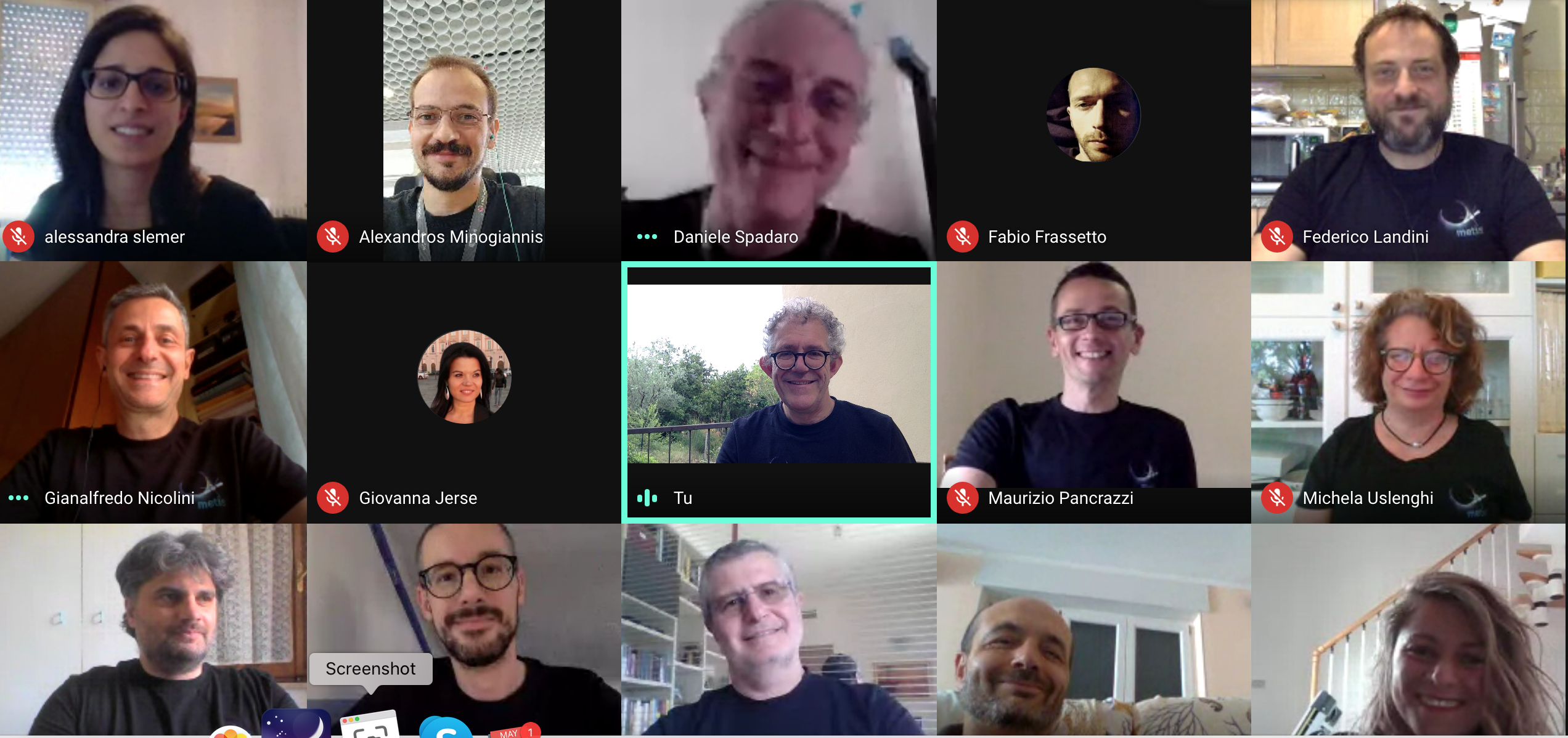
Thanks to all Metis Team that is supporting the calibration activities!
Even though perfomed remotely because of Covid-19 pandemic restrictions, the activity was successful and the first images in both visible light and UV were acquired that show no evident stray-light contamination.
Metis UV first light
April 23, 2020
Today the commissioning of the Metis UV detector was completed, and the first UV images with door open were taken.
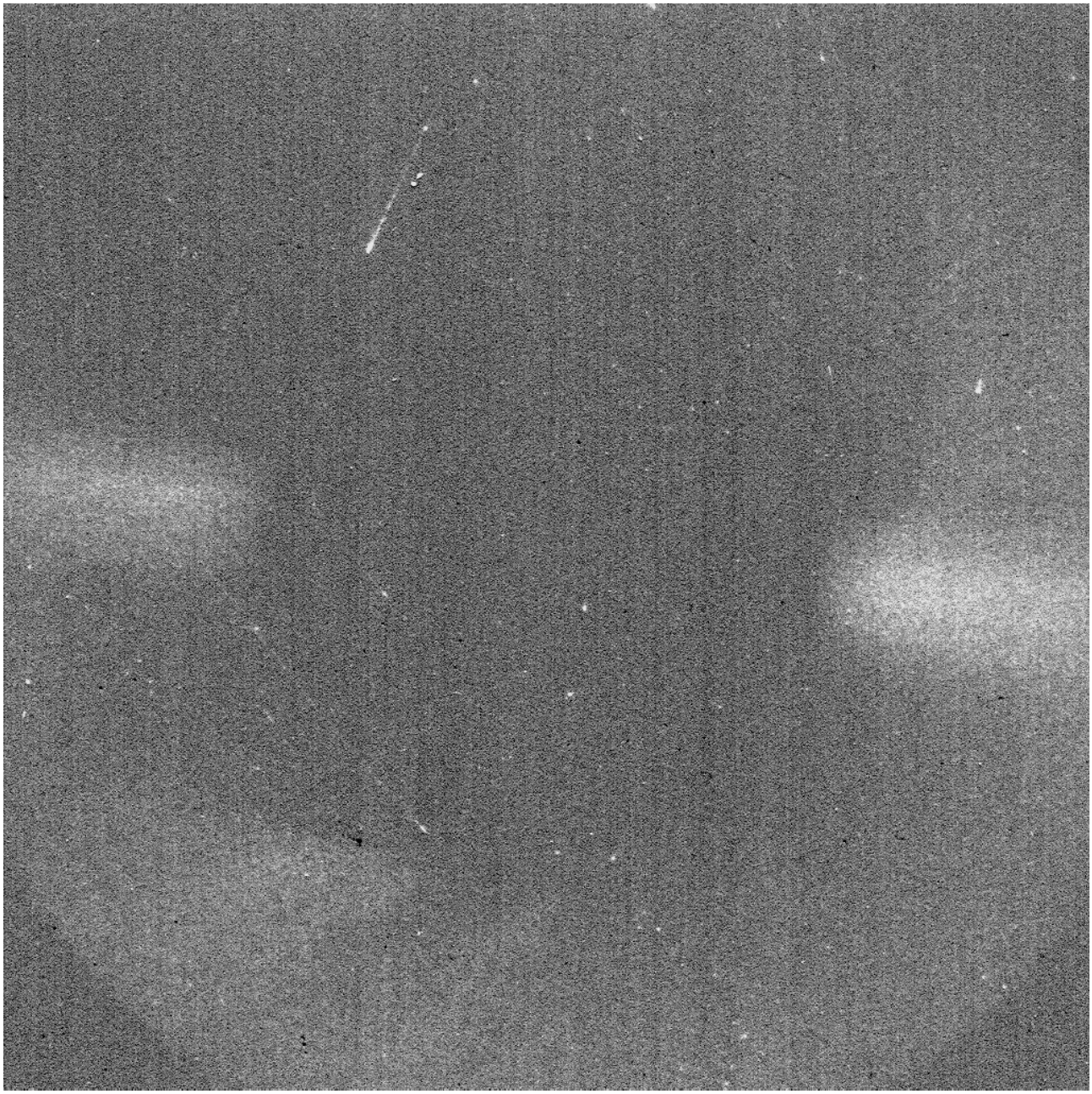
UV image acquired on April 23, 2020.
They clearly show Lyman-α emission in the equatorial corona from 4.7 to 8.5 solar radii from Sun's center (this is the present Metis field of view).
“We are looking forward to getting even better images when the position of the internal occulter will be optimized in the upcoming commissioning activities”, Marco Romoli (Metis PI) says.
Metis cap successfully ejected and visible-light first images
March 13, 2020
Metis door was successfully opened today and the Metis cap ejected out across the solar system.
The first images taken with the visible-light channel and the door open are being analysed. A preliminary inspection of the images, suggests that there is a small displacement of the internal occulter from its nominal position (the position achieved during on ground calibration). From ground testing, we are confident that this kind of displacement can be corrected.
It will be fixed in one of the next commissioning activities, where we will be able to see the solar corona and say hopefully goodbye to the coronavirus!
Metis switch-on
February 27, 2020
Despite the spreading of Covid-19 pandemic, that decimated the fierce Metis Team in Darmstadt, today Metis was successfully switched on and underwent a flawless SFT (Short Functional Test) before being turned off.
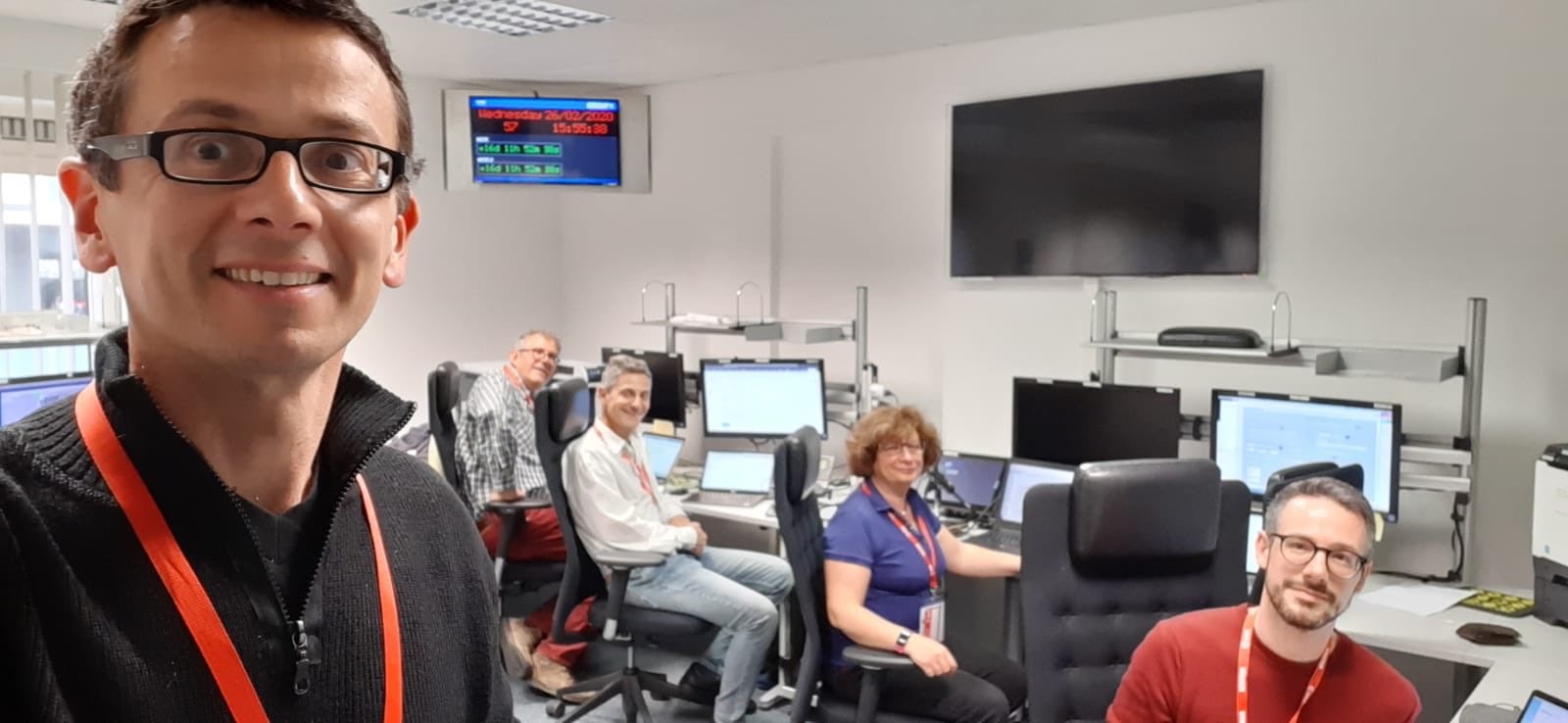
Thermal interfaces work fine and the whole optical units is around 0° Celsius.
Solar Orbiter successfully launched
February 10, 2020
ESA's Solar Orbiter mission lifted off on an United Launch Alliance Atlas V rocket from Cape Canaveral, Florida (USA), at 05:03 CET on Monday, February 10th. At 06:24 CET, mission controllers at the European Space Operations Centre (ESOC) in Darmstadt, Germany, received a signal from the spacecraft indicating that its solar panels had successfully deployed.
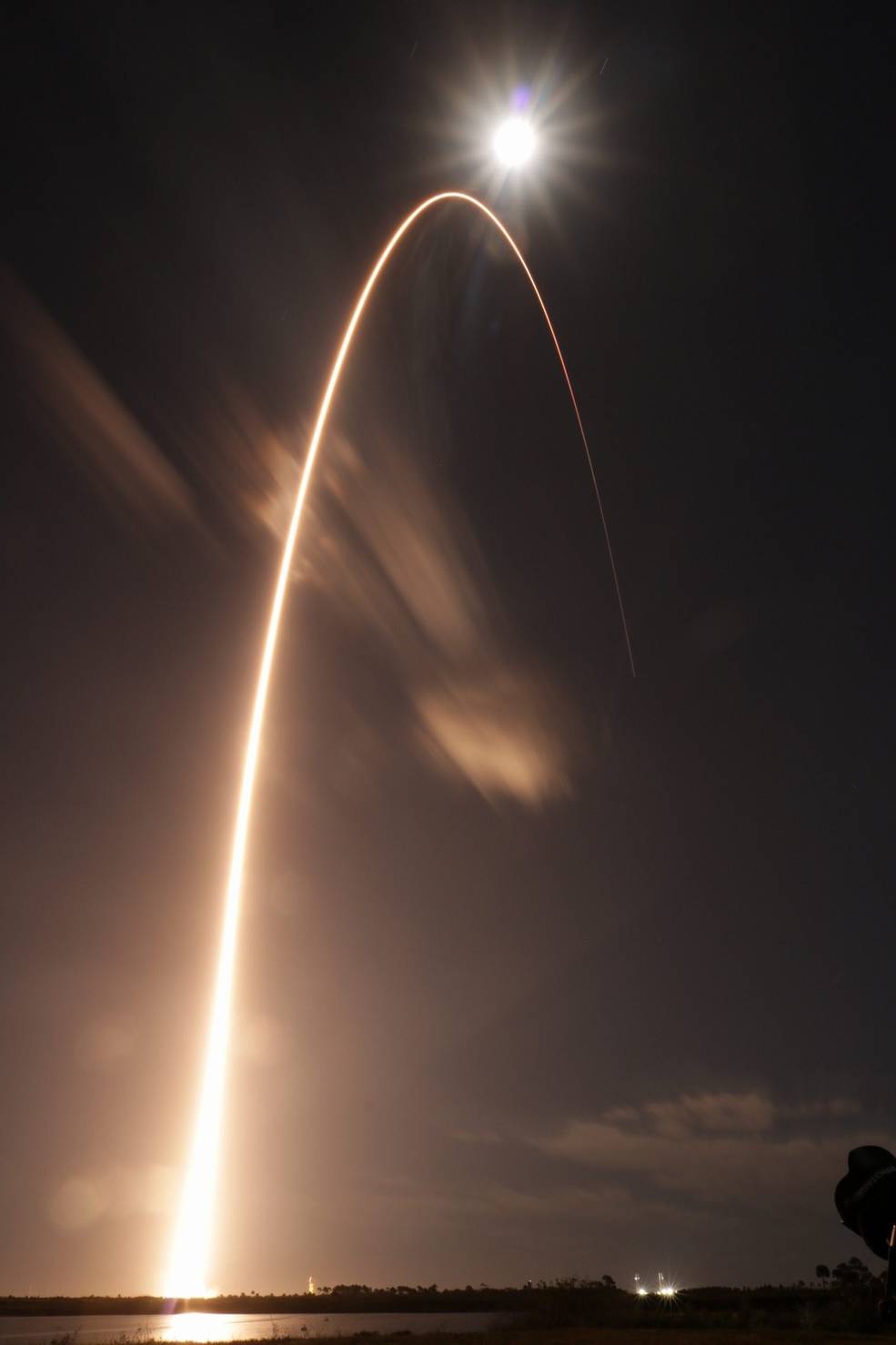
Launch of the ESA/NASA Solar Orbiter mission from Cape Canaveral Air Force Station in Florida on February 10, 2020. Credits: Jared Frankle, NASA Solar Orbiter Social Participant
Solar Orbiter is now on a unique trajectory towards the inner solar system. Over the next days, the spacecraft will deploy its instrument boom and antennas that will allow it to communicate with Earth. Then, it will spend about three months in a commissioning phase, during which several checks will be run on the spacecraft's scientific payload to ensure its 10 instruments are working properly.
It will take Solar Orbiter about two years to reach its operational orbit around the Sun, where it will capture unprecedented images of our star's poles. This journey includes 22 close approaches to the Sun, bringing the spacecraft at one third of the Sun-Earth distance, within the orbit of Mercury, to study the Sun and its influence on the heliosphere.
2019
Announcement of the Solar Orbiter InfoDay
November 15, 2019
In preparation for launch and the subsequent start of the Solar Orbiter science operations, the Agenzia Spaziale Italiana (ASI) in collaboration with the European Space Agency (ESA) is organizing a one-day meeting, the “Solar Obiter InfoDay”, to present in detail the mission to the community.
The meeting will be held on December 2nd, 2019, at the ASI headquarter in Tor Vergata, Rome.
After an overview of the general aspects and instruments, the Italian contributions, data products, and data policy, an open discussion to foster new collaborations and synergies is foreseen. Members of the scientific community interested in the Solar Orbiter science are warmly invited.
Further information for registration and logistics can be found at the following link.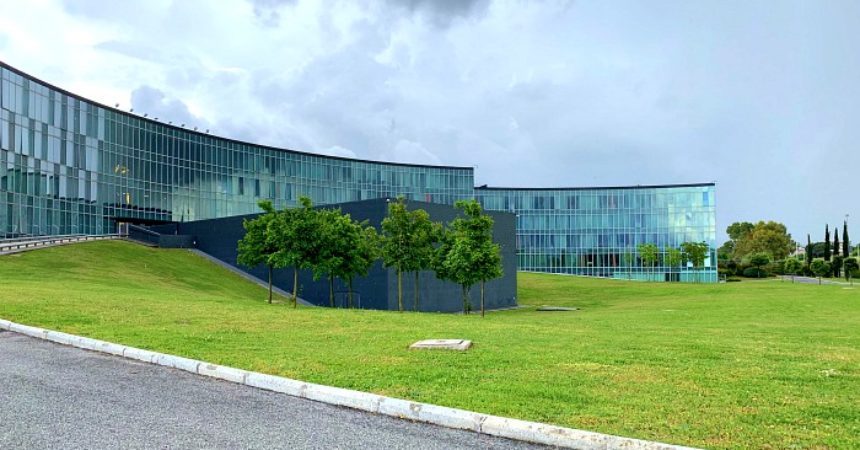
The Agenzia Spaziale Italiana (ASI) headquarter in Tor Vergata, Rome
Solar Orbiter is now in Cape Canaveral after it had completed its test campaign
November 2, 2019
The 18th of October, ESA’s Solar Orbiter was on display for the final time in Europe, at the IABG test centre near Munich, Germany. Scientists and journalists greeted the probe in the same day, finally ready for its journey to Cape Canaveral, Florida, USA. The spacecraft was built at Airbus Stevenage, UK, and has spent the last year at IABG undergoing essential testing such as checking deployment mechanisms, and that it can withstand the vibrations of launch, and the thermal extremes and vacuum of space.
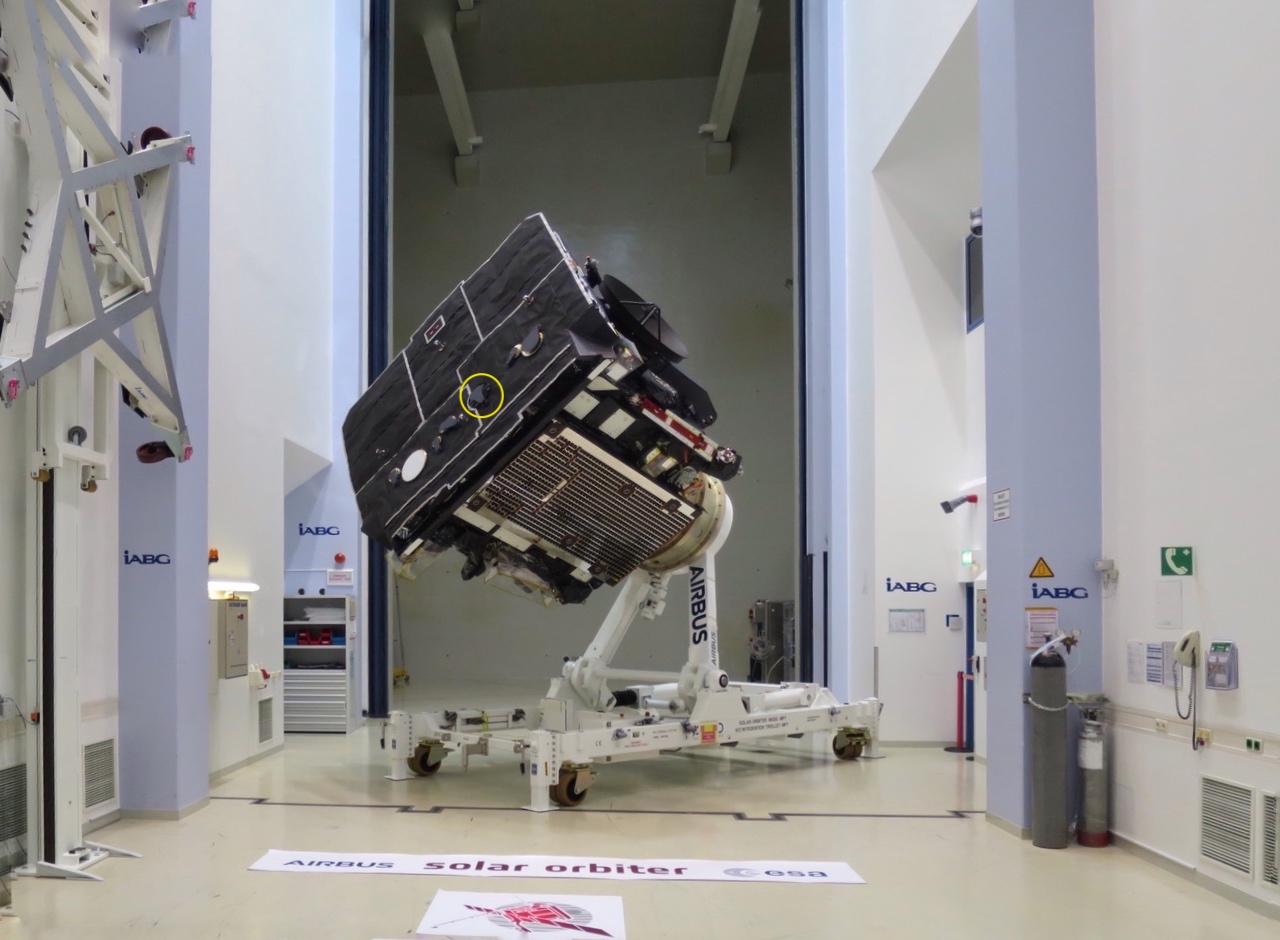
The Solar Orbiter spacecraft on show at the IABG (Munich, Germany) after it has finished its test campaign in preparation to the launch
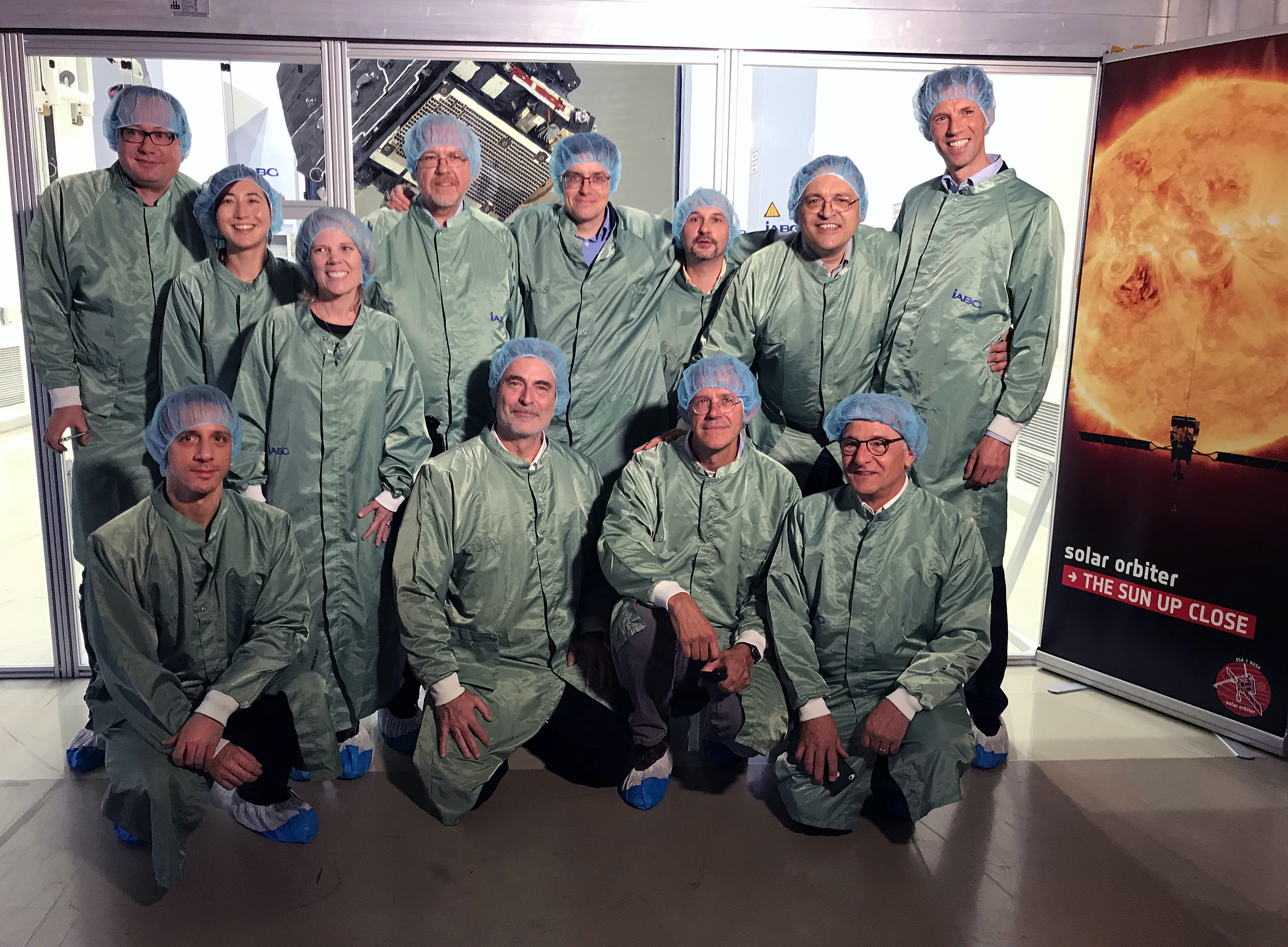
Group photo of the principal and co-principal investigators of the Solar Orbiter spacecraft instruments
On November 1st, Solar Orbiter travelled on an Antonov cargo plane to reach the Kennedy Space Center in Florida from where it will be launched on a NASA-provided Atlas V 411. The launch is currently scheduled in the late hours (local time) of February 5th, 2020.
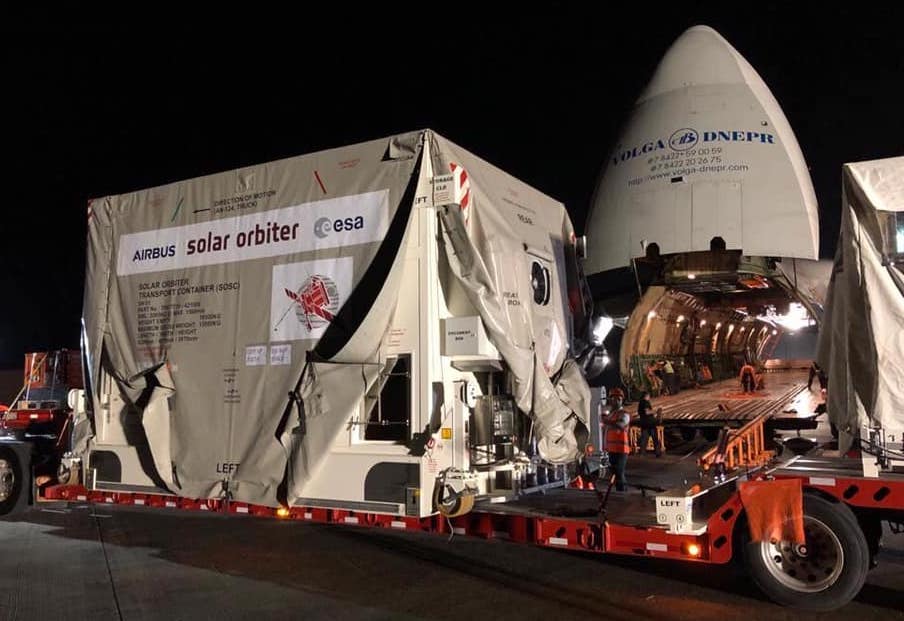
Once in space, and over the course of several years, Solar Orbiter will use the gravity of Venus and Earth to raise its orbit above the poles of the Sun, providing new perspectives on our star, including the first images of the Sun’s polar regions. Its complementary suite of instruments means it will be able to study the plasma environment locally around the spacecraft, and collect data from the Sun from afar, connecting the dots between the Sun’s activity, and the space environment in the inner Solar System.
Metis cap ejection test and door mechanism functional test
August 1-2, 2019
On August 1 and 2, the Metis cap ejection test was performed in conjunction with the external door mechanism functional test. Metis cap ejection is triggered mechanically by the opening of the external door. Sener (Spain) designed and built the door mechanisms for all the instruments, and the Metis cap.
The test was carried on in the Halle B cleanroom facility of IABG in Munich. Door opening and cap ejection were performed at the end of the activities on August 1.
Due to the high demanding requirements on particle cleanliness (no particles must be present with size above 100 μm), in the early morning of August 2, that allowed the settling of particles inside the clean room, the inner protective cap was removed, leaving Metis open for about 10 minutes, allowing inspection and cleaning in visible and UV light. Afterwards the ejectable cap was re-assembled and the door successfully closed.
This is the last mechanical test on the instrument before launch.
7th Metis workshop announcement
July 15, 2019

View of Palazzo del Bo in Padua (Italy), where the 7th Metis workshop will be held
On 11-13 November 2019, Padua (Italy) and its historical University will host the 7th Metis Workshop.
At a few months from the Solar Orbiter launch, this will be the best opportunity to meet and discuss about Metis science perspectives, in an environment full of art, science, and history.
The workshop will be devoted to a detailed introduction of Metis to the solar and the heliospheric community, in order to define the scientific planning strategy and to propose science with Metis and the Solar Orbiter, in synergy with other current and planned space missions, such as PSP, PROBA-3, Bepi Colombo, and ground based instrumentation.
Further information can be found on the workshop webpage.
2018
Metis cap mechanism successfully integrated
October 29, 2018
The Metis cap release mechanism has been installed today. The cap is designed to prevent the deposition of dust particles on the IEO (Inverted External Occulter) edge and inside the instrument, during on-ground integration and test activities and during launch and early orbit phase.
The sealing cap ejection system is a one-shot mechanism planned for use at the very beginning of the mission, after the outgassing of the instrument. Afterwards, the Metis aperture will remain open; direct Sun-disk light protection will be provided when needed by closing the Solar Orbiter external door.
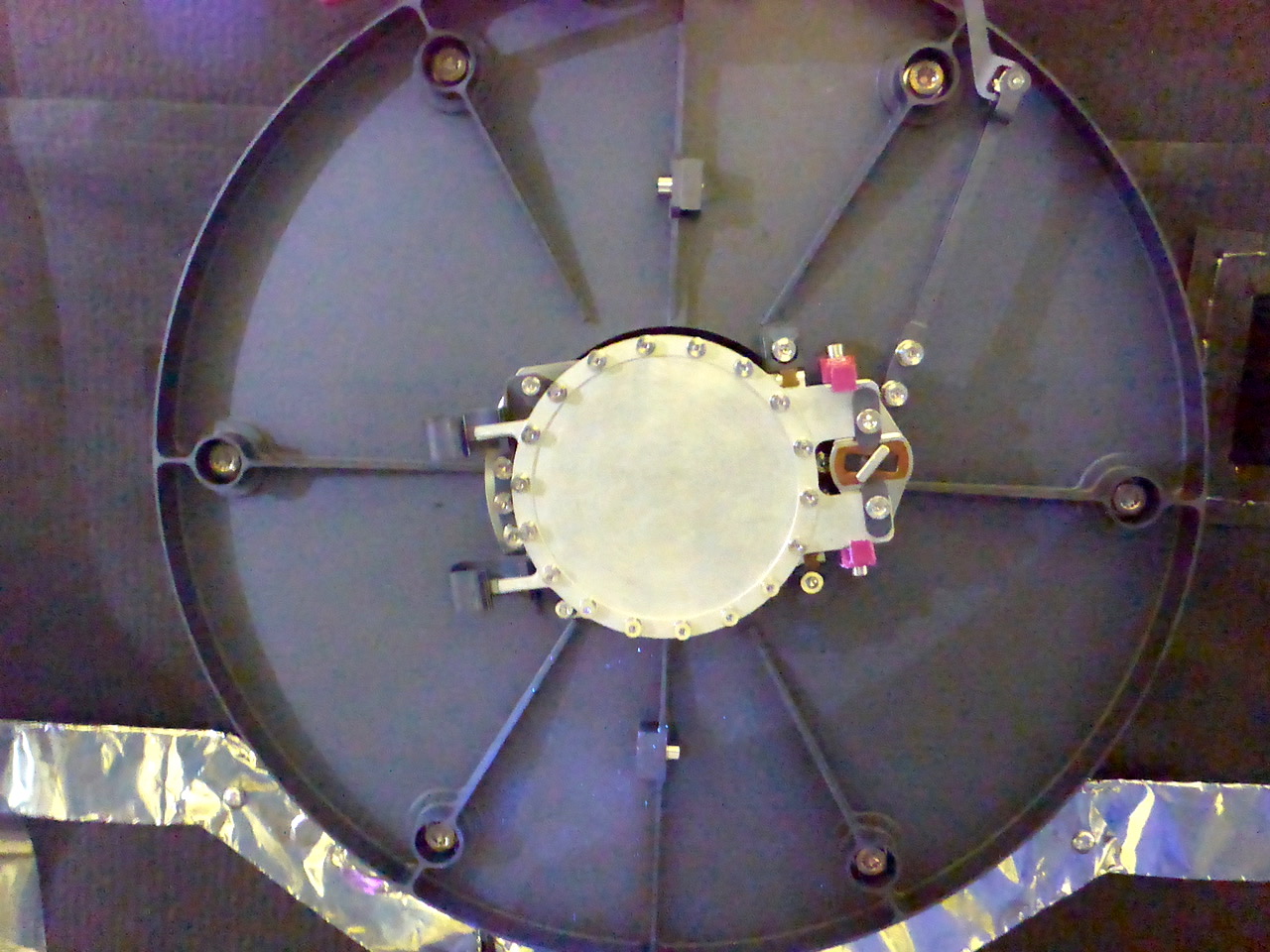
The Metis cap before integration of the door mechanism
Installation of the Solar Orbiter heat shield on the Solar Orbiter spacecraft
October 24, 2018
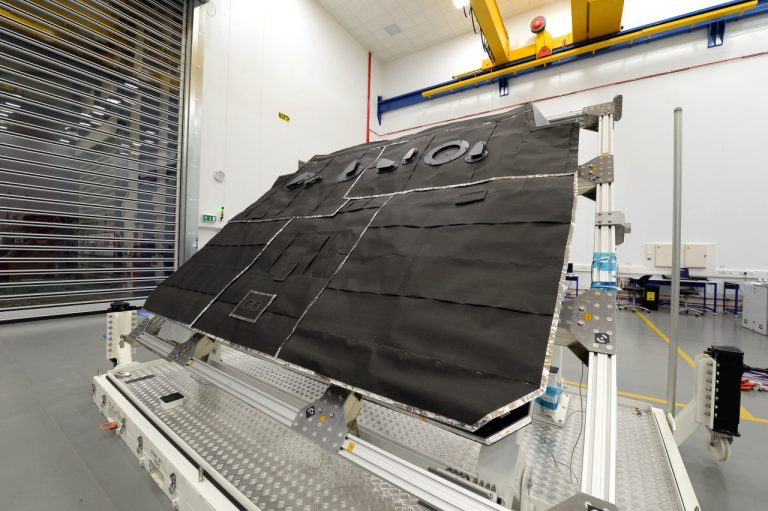
The Solar Orbiter heat shield before integration in the spacecraft
The heat shield has been installed successfully on the Solar Orbiter spacecraft, on October 24, 2018. This high-tech system, which is composed of several layers of titanium and an outer covering with a protective film developed specifically for Solar Orbiter, “Solar Black”, will guarantee the safety of the spacecraft instruments. The “sliding doors” on the heat shield will further protect the instrument entrance windows and optical elements.
“This is another big step in Solar Orbiter way to launch!” says Sandie Deslous, Airbus Stevenage (UK).
Solar Orbiter shipped to IABG in Germany for the final tests
September 18, 2018
“It's taken a little longer than expected but the Solar Orbiter probe is built and ready to begin testing. UK engineers are putting the finishing touches to the satellite this week before sending it to Germany to begin a year-long test campaign. Such attention to detail is necessary because of the punishing conditions the spacecraft will experience when studying our star's inner workings.”
Read the complete article on the BBC webpage and the interview to the Metis Co-I Vincenzo Andretta (INAF – Astronomical Observatory of Capodimonte, Naples) on Media INAF.
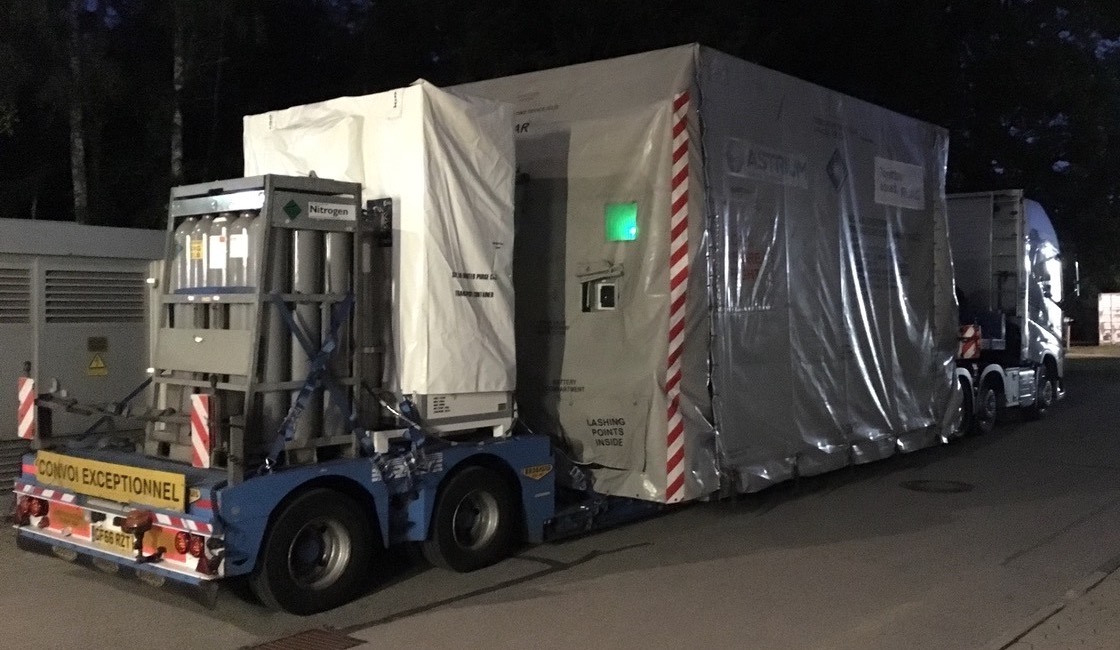
The convoy carrying Solar Orbiter, upon arrival at the IABG in Ottobrunn, Munich (DE)
6th Metis workshop announcement
September 14, 2018
After successful integration in the spacecraft, Metis is now undergoing spacecraft environmental tests. All activities are in line with the planned Solar Orbiter launch in February 2020 and with the start of its nominal mission at the end of 2021. Scientific planning of the mission is now becoming more detailed.
The 6th Metis Workshop will be devoted to a detailed introduction to Metis for all the potential users of the instrument and of Solar Orbiter, in order to define the scientific planning strategy and to propose science with Metis and other space and ground instrumentation. Half day will focus on science and a poster session is foreseen.
The meeting will be held at the Max Planck Institut für Sonnenforschung in Göttingen from 21 to 23 November, 2018, starting in the afternoon of 21st and ending in the morning of 23rd. For further information about the workshop and the meeting venue, please visit the workshop webpage.

The Max Planck Institut für Sonnenforschung in Göttingen (Germany), where the 6th Metis workshop will be held
Solar Probe on its way to the Sun
August 13, 2018
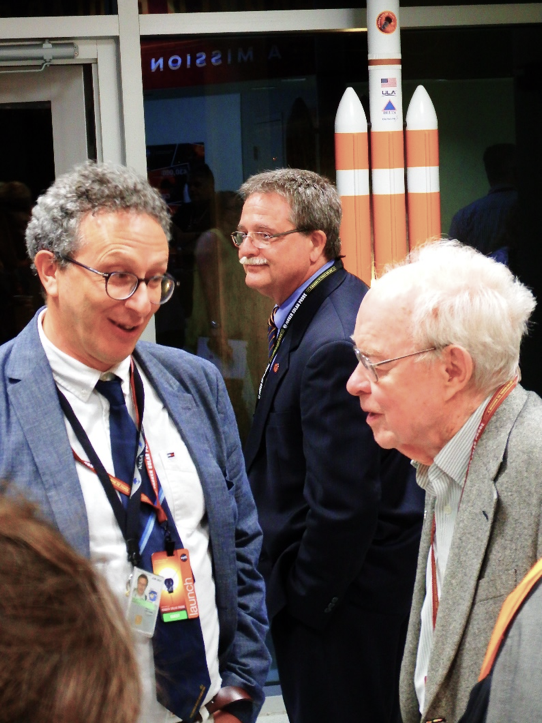
Eugene N. Parker, the ‘father’ of the solar wind, with Marco Velli, Parker Solar Probe Scientist and Metis Co-I, during the Probe launch at Cape Canaveral Air Force Station, Florida
Parker Solar Probe has successfully initiated its fantastic journey to touch the Sun. In synergy with the Parker Probe, designed to explore on the ecliptic plane the innermost heliosphere and cross the solar corona itself in its journey around the Sun, Solar Orbiter, to be launched on February 2020, will explore the out of ecliptic heliosphere close to the Sun.
Metis has the capability, when allowed by the geometry of the orbits of the two spacecrafts, to image light the coronal regions crossed by the Parker Probe during its transit in the solar corona, thus measuring the overall properties of the plasma environment sampled locally by the Probe.
Panel mating onto the Solar Orbiter spacecraft
July 18, 2018
Last picture of Metis before panel mating onto the Solar Orbiter spacecraft at Airbus Defence & Space, Stevenage, UK. In order to preserve the high cleanliness standard of the instrument, the telescope entrance aperture is protected by a MLI (Multi-Layer Insulation) blanket, that will be removed afterwards.
“We will not see Metis anymore, but it will certainly show in space what it is capable to do!” says Marco Romoli, the Metis PI.
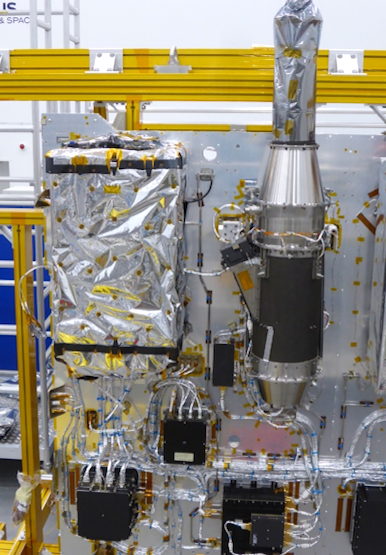
Last picture of Metis
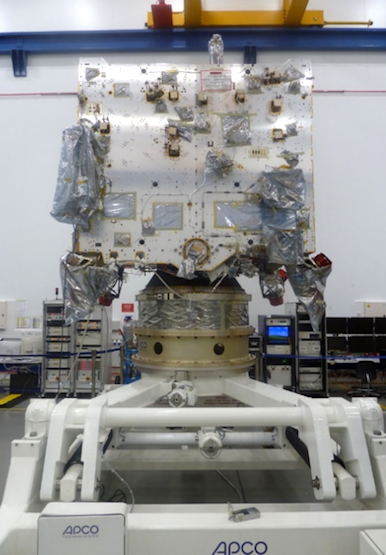
Solar Orbiter without heat shield seen from the -Y face, the face in the direction of motion. Metis boom appears on top of the spacecraft
2017
Ejectable cap installation on Metis
November 3, 2017
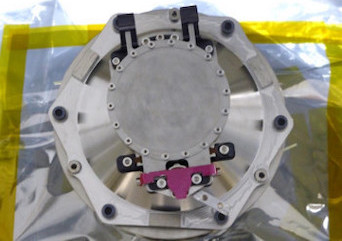
Metis ejectable cap
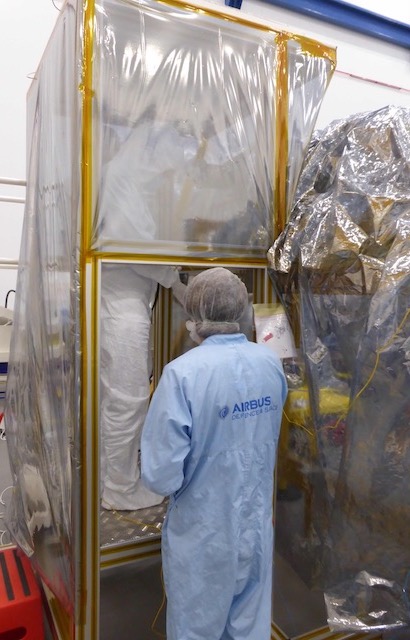
ISO 5 cabin used during the installation of the Metis cap at Airbus Defence & Space, Stevenage (UK)
On November 3rd at Airbus Defence & Space, Stevenage (UK), the Metis ejectable cap was successfully installed on the external occulter aperture of Metis, replacing the temporary cap that was protecting the entrance aperture of the telescope from particulate and molecular contamination.
The protective cap, designed and manufactured at Sener, Bilbao, will be ejected to space shortly after the spacecraft launch. The installation was performed in an ISO 5 specially built cabin with the participation of TAS-I cleanliness expert, Metis PI, and Sener mechanical expert.
